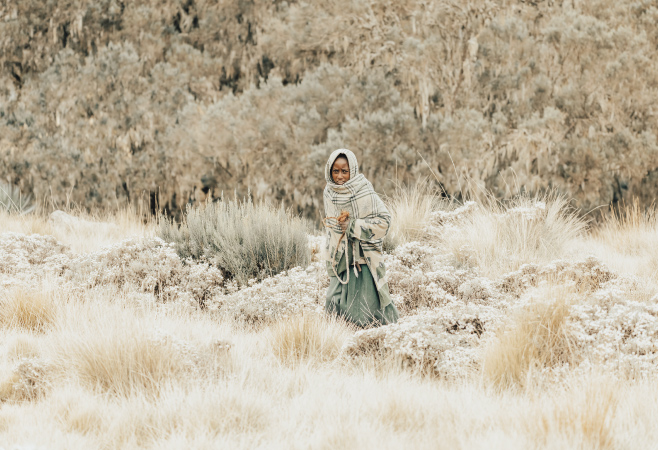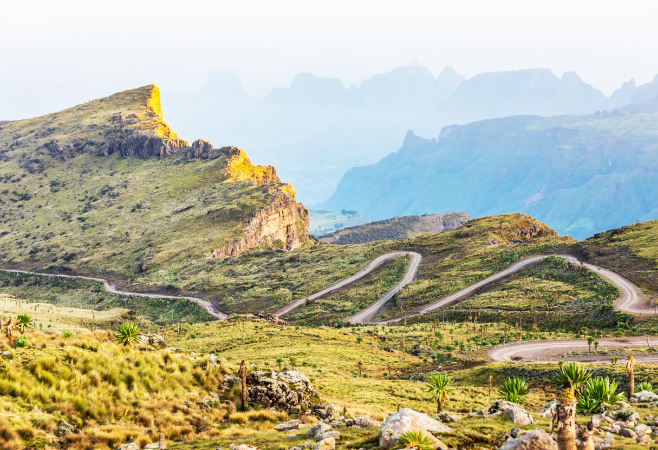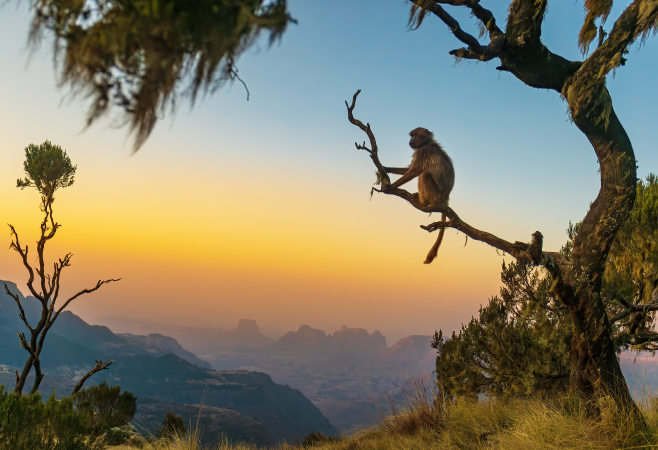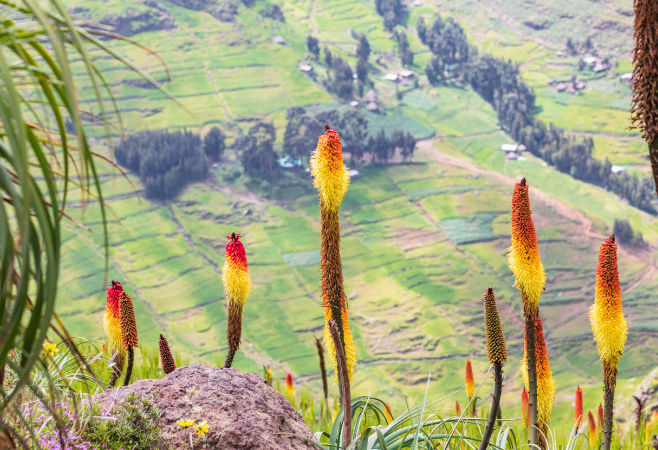Ethiopian Highlands Travel Tips: Things Must See & Do
The Ethiopian Highlands refer to a vast, rugged, and majestic mountainous region that covers a significant portion of Ethiopia. Often called the "Roof of Africa" due to its sheer size and high altitudes, it's the largest continuous area of high elevation on the entire continent. The Ethiopian Highlands is home to dramatic landscapes perfect for trekking, incredible endemic wildlife, and iconic UNESCO World Heritage Sites like Lalibela, Axum, and Gondar.
 Learn a few Amharic phrases when visiting Ethiopia's highlands — it goes a long way in highland villages
Learn a few Amharic phrases when visiting Ethiopia's highlands — it goes a long way in highland villages
Where are the Ethiopian Highlands located?
The Ethiopian highlands (also called the Abyssinian Highlands) are located in the Horn of Africa, between 7°N and 12°N latitude. It covers much of central and northern Ethiopia, forming Africa's largest continuous mountain range.
Major cities within the highlands: Addis Ababa, Gondar, Lalibela, Axum.
Some interesting facts about the Ethiopian Highlands
They are often called the "Roof of Africa" due to their elevation.
Home to 80% of Africa’s land above 3,000 meters.
Birthplace of the Blue Nile River.
The region has some of the world’s oldest Christian heritage sites.
What animals live in the Ethiopian Highlands?
The region is a biodiversity hotspot with many endemic species, including:
- Ethiopian wolf (Africa’s most endangered carnivore)
- Gelada baboon
- Walia ibex
- Mountain nyala
- Bale monkey
Over 800 bird species, including Prince Ruspoli’s turaco and Harwood’s spurfowl.
What plants grow in the Ethiopian Highlands?
The flora is part of the Afromontane ecosystem, with:
- Juniperus procera and Afrocarpus gracilior (conifers)
- Hagenia abyssinica, Syzygium guineense, and giant lobelias
- Wild coffee (Coffea arabica) in the Harenna Forest
 The Ethiopian highlands offer unmatched photo ops
The Ethiopian highlands offer unmatched photo ops
Top 6 Must-Visit Places in the Ethiopian Highlands
Wondering where to start? Here are the must-visit spots in the Ethiopian highlands that every traveler should know about.
1. Lalibela: The Land of Rock-Hewn Churches
Lalibela is a UNESCO World Heritage Site, which is famous for its 11 medieval rock-hewn churches, carved straight out of the rock in the 12th century. These churches are still active places of worship, offering a glimpse into Ethiopia’s deep Christian heritage.
The best time to visit is October to March for cooler weather and fewer crowds. Visit during Timkat (Ethiopian Epiphany) in January for vibrant festivals and ceremonies.
2. Simien Mountains National Park: A Hiker’s Paradise
The Simien Mountains National Park is a must for hiking and jaw-dropping views. This UNESCO site is home to rugged peaks, deep valleys, and unique wildlife like the gelada baboon and the rare Ethiopian wolf.
The list of things to do in the Simien Mountains includes a must-do trek, wildlife spotting, and photography.
- Trekking: Choose from day hikes or multi-day treks to peaks like Ras Dashen (4,550m).
- Wildlife Spotting: Keep an eye out for gelada baboons, ibex, and rare birds.
- Photography: The dramatic cliffs and sunsets make this a photographer’s dream.
Visit the Simien Mountains from November to February for clear skies and ideal trekking conditions. You’ll need a guide and park permit, easily arranged in Debark, the gateway town.
 The Ethiopian highlands are a traveler’s tapestry of heritage and nature
The Ethiopian highlands are a traveler’s tapestry of heritage and nature
3. Axum: The Cradle of Ethiopian Civilization
History lovers, Axum is your spot. This ancient city was once the heart of the Aksumite Empire, one of Africa’s greatest civilizations.
It’s home to towering obelisks, ancient ruins, and the legendary Church of St. Mary of Zion, rumored to house the Ark of the Covenant.
Highlights of Axum
- The Obelisks: These massive stone steles are some of the tallest in the world, dating back over 1,700 years.
- Archaeological Sites: Explore the ruins of palaces and tombs from the Aksumite period.
- Cultural Immersion: Chat with locals to learn about Axum’s myths and traditions.
4. Gondar: The Camelot of Africa
Known as the “Camelot of Africa,” Gondar boasts stunning castles and a royal vibe. The Fasil Ghebbi (Royal Enclosure) is a UNESCO site with beautifully preserved palaces from the 17th and 18th centuries.
Gondar stands out with Fasil Ghebbi with its mix of African and European architectural styles, and colorful frescoes of Debre Birhan Selassie Church.
The ideal time to visit Gondar is from November to March for mild weather, and to enjoy traditional Ethiopian coffee ceremonies and bustling markets.
5. Bale Mountains National Park: A Biodiversity Haven
For nature lovers, the Bale Mountains are a hidden gem filled with biodiversity. From montane forests to alpine meadows and extinct volcanic peaks, this park is a paradise for wildlife enthusiasts. It makes Bale Mountain become one of the places to see wildlife in Ethiopia.
Visit the Bale Mountains and explore vast plateaus, bamboo forests, and cloud-covered valleys. Visitors can spot the elusive Ethiopian wolf, Bale monkeys, and over 800 bird species.
 The Ethiopian Highlands are home to endemic wildlife like the gelada baboon
The Ethiopian Highlands are home to endemic wildlife like the gelada baboon
6. Blue Nile Falls: Ethiopia’s “Smoking Water”
Locally known as Tis Issat ("Water that Smokes"), the Blue Nile Falls is one of Ethiopia’s most awe-inspiring natural wonders. During the rainy season, the falls thunder with power, sending up clouds of mist.
Ideal spot for light trekking, riverside picnics, and amazing photos. Visit Blue Nile Falls from June to September for the most impressive water flow, perfect for nature lovers.
Plan a trip to the Ethiopian Highlands
When Is the Best Time to Visit the Ethiopian Highlands?
The best time to visit is during the dry season, from October to March. The weather is ideal for trekking and exploring cultural sites. Avoid the heavy rains from June to September, especially if you’re planning to hike.
How can I get there?
Most travelers fly from Addis Ababa to Lalibela, Gondar, or Axum (1–2 hours) via Ethiopian Airlines; buses are cheaper but take 8–12 hours. Then arrange tours or car hire with guides. This makes exploring the Simien Mountains and surrounding areas much easier.
To get around the Ethiopian Highlands, renting a 4x4 or trekking is the most common option.
Where to Stay in the Highlands?
You’ll find a mix of eco-lodges, local guesthouses, and mid-range hotels, especially around tourist areas like Lalibela and Gondar.
- Simien Lodge – High-altitude luxury near the Simien Mountains
- Tukul Village (Lalibela) – Great views and traditional architecture
- Goha Hotel (Gondar) – Comfortable base with a historic vibe
What should I prepare for the trip?
- Warm clothing: Nighttime temperatures can drop below 10°C.
- Hiking boots: Essential for navigating steep and rocky terrain.
- Altitude sickness medication: Some areas exceed 3,000m in elevation.
Check current security and health advisories for Ethiopia before you travel.
 Breathtaking vistas from the Ethiopian Highlands
Breathtaking vistas from the Ethiopian Highlands
FAQs About Traveling to the Ethiopian Highlands
Is the Ethiopian Highlands safe for tourists?
Yes, most highland regions popular with tourists are safe and welcoming. However, always check current travel advisories, and consider hiring local guides for treks and cultural visits for safety and deeper insight.
Do I need a visa for Ethiopia?
Yes, most visitors must apply for a visa in advance (e-Visa is available online) to enter Ethiopia
Who is the Ethiopian Highlands suitable for?
Ideal for nature lovers, hikers, photographers, and travelers interested in culture and history.
Not recommended for those with health issues related to high altitude or who prefer luxury travel.
Are the Ethiopian Highlands also known as the Abyssinian Highlands?
Yes. "Abyssinian Highlands" is another name for the Ethiopian Highlands, based on the ancient kingdom of Abyssinia, a historic name for Ethiopia.
Does it snow in the Ethiopian Highlands?
Yes — but rarely. Snow may fall on high peaks like Ras Dashen during the coldest months (mainly December to February), though it doesn’t last long or accumulate much.
Frost is common at sunrise in elevations above 2,400 meters, especially during the dry season.
What are the main mountains in the Ethiopian Highlands?
The most prominent mountains include:
- Ras Dashen – the highest peak in Ethiopia (4,550m)
- Simien Mountains – dramatic cliffs and escarpments
- Bale Mountains – located further south, rich in biodiversity
Final Thoughts: Are the Ethiopian Highlands Worth It?
Yes, whether you're a hiker, culture lover, history buff, or wildlife enthusiast, the Ethiopian Highlands deliver a one-of-a-kind African travel experience. If you’re looking for an off-the-beaten-path adventure, start planning your journey to this awe-inspiring region today!
Related Articles
- Ethiopian Rift Valley: A Complete Travel & Geography Guide
- Ethiopia e-Visa for Minors: Guide for Parents and Families
- Top Active Volcanoes in Ethiopia You Must See
- Experiencing the Ethiopian Coffee Ceremony as a Visitor
- Exploring Dorze Village: What to See and Do
- Top Travel Apps for Visiting Ethiopia
- Top Destinations for Historic Holidays in Northern Ethiopia
- Ethiopia Entry Requirements for African Travelers
- Bole Addis Ababa International Airport: What Travelers Need to Know





